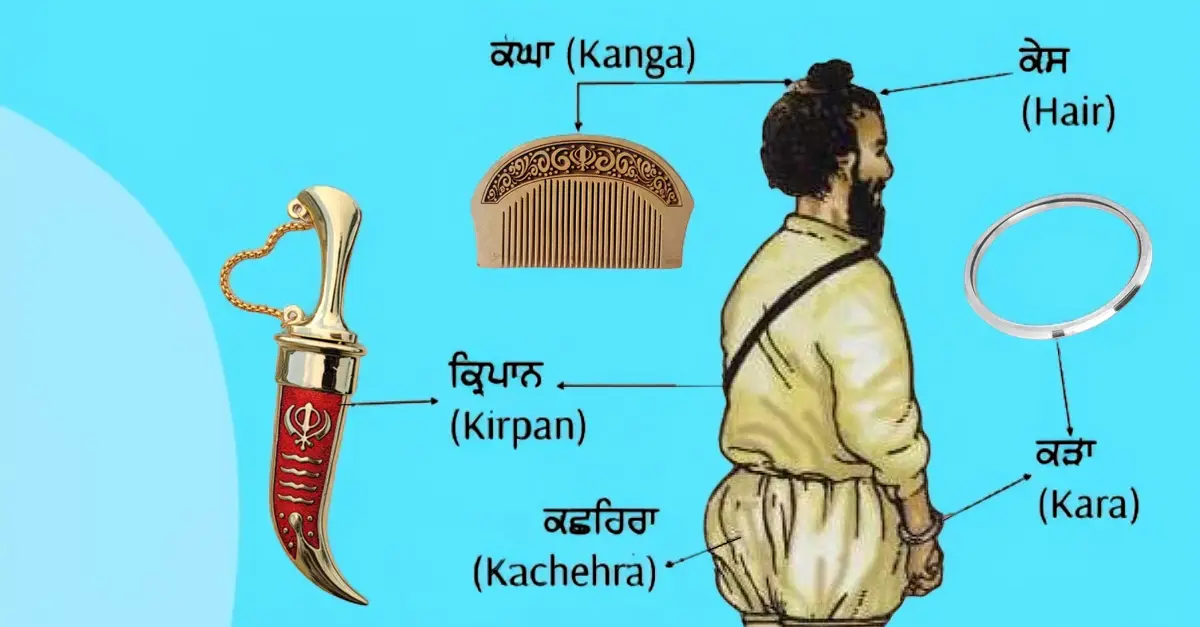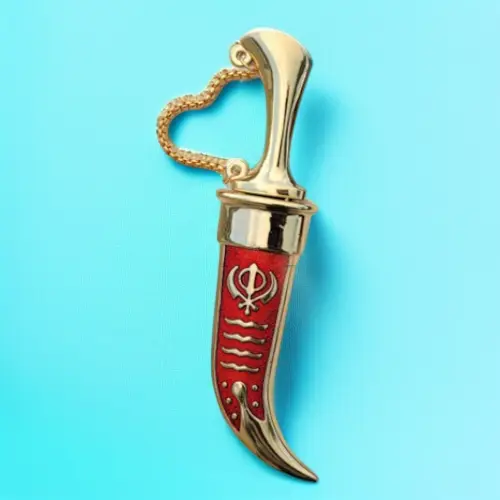5 Kakar - Five Sikhism Symbol

5 Kakar - Five Sikh Kakar
The 5 Kakar, also known as the Five Kakar, are five sacred symbols that initiated Sikhs (Khalsa) are required to wear at all times as part of their religious and spiritual discipline. Mandated by Guru Gobind Singh in 1699, these articles represent Sikh identity, faith, and commitment to the principles of Sikhism. Each Kakar has a specific spiritual and practical significance:
1. The Kirpan: The Sword of Compassion and Protection

Kirpan
The Kirpan is a ceremonial dagger or small sword carried by initiated Sikhs, known as Amritdhari Sikhs, who have undergone the Amrit Sanskar (baptism ceremony). Far from being a weapon of aggression, the Kirpan symbolizes the Sikh duty to defend the oppressed and uphold justice. Its name is derived from two Punjabi words: kirpa (mercy) and aan (honor), reflecting its role as an instrument of compassion and dignity.
Spiritual Significance: The Kirpan reminds Sikhs to fight against injustice, both within themselves and in society. It represents the inner struggle against ego, anger, and greed, as well as the external duty to protect the weak.
Practical Role: Historically, the Kirpan was a practical tool during conflict, particularly during the Mughal era when Sikhs faced religious persecution. Today, it is a sacred article of faith, worn at all times by baptized Sikhs.
The size and style of the Kirpan can vary, ranging from a few inches to over a foot in length, but it is always sheathed and worn respectfully, often strapped across the body or secured in a gatra (a special belt). In modern contexts, the Kirpan has sparked discussions about religious freedom, as Sikhs advocate for the right to carry it in public spaces like schools and airports.
The Kirpan is one of the 5 Kakar (articles of faith that Sikhs are required to carry. It emphasizes discipline and readiness to serve humanity. It is a constant reminder that power must be wielded with responsibility and compassion. (5 Kakar)
2. The Karda: The Circle of Unity and Righteousness

Karda
The Kara is a steel or iron bangle worn on the wrist, typically on the right hand, by Sikhs. It is another of the Five Ks and holds both practical and symbolic importance. The Kara is simple in design—unadorned and circular—but its meaning is profound.
Symbolism: The circular shape of the Kara represents eternity and the oneness of God. It reminds Sikhs to live a life of integrity, free from attachment to material possessions, and to act with righteousness in all endeavors.
Practical Use: Historically, the Kara served as a protective guard for warriors, shielding the wrist during combat. Today, it is a constant reminder of the wearer’s commitment to Sikh values, such as honesty, humility, and service.
The Kara is typically made of steel, symbolizing strength and resilience, rather than precious metals like gold or silver, which aligns with Sikhism’s emphasis on humility and equality. It is worn at all times, even during sleep or bathing, as a tangible connection to the Sikh faith.
In daily life, the Kara serves as a subtle yet powerful reminder of one’s responsibilities. For example, when a Sikh reaches out to act—whether to help someone or to make a decision—the Kara’s presence on the wrist prompts reflection on whether the action aligns with Sikh principles. (5 Kakar)
3. The Kangha: The Comb of Discipline and Cleanliness

Kangha
The Kangha is a small wooden comb carried by Sikhs to maintain their uncut hair, another of the Five Ks. It is typically tucked into the hair under the turban and is used regularly to keep the hair neat and tidy.
Spiritual Meaning: The Kangha symbolizes discipline, cleanliness, and order. It reflects the Sikh belief in maintaining a balanced and organized life, both physically and spiritually. By caring for their hair, Sikhs demonstrate respect for the body as a gift from God.
Cultural Context: In Sikhism, hair (Kes) is considered sacred and is never cut, as it represents acceptance of God’s will. The Kangha ensures that this hair is kept dignified, free from tangles and dirt.
The Kangha is often made of wood, sometimes with intricate carvings, and is small enough to be carried easily. It is a practical tool and a reminder of the importance of self-discipline in all aspects of life—whether in personal hygiene, time management, or ethical conduct.
The Kangha’s significance extends beyond its physical use. It encourages Sikhs to comb through their thoughts and actions, ensuring they remain free of negativity and aligned with the teachings of the Guru Granth Sahib, the Sikh holy scripture. (5 Kakar)
4. The Kesh: The Uncut Hair of Devotion

Kesh
The Kesh, or uncut hair, is one of the most visible and sacred symbols of Sikhism. Sikhs maintain their hair in its natural state, never cutting or trimming it, as a sign of respect for God’s creation. For men and women alike, the Kes is covered with a turban (dastar) or headscarf, which adds to its dignity and serves as a public declaration of faith.
Spiritual Significance: The Kes represents acceptance of God’s will and the rejection of vanity. By keeping their hair natural, Sikhs embrace humility and live in harmony with the divine order.
Historical Context: During the time of the Sikh Gurus, keeping uncut hair was a bold act of defiance against forced conversions and cultural assimilation. It became a hallmark of Sikh identity, especially under Guru Gobind Singh Ji, who formalized the Five Ks in 1699.
The turban, which protects and covers the Kes, is itself an important symbol of sovereignty, discipline, and equality. Sikh men and women tie their turbans with care, often in vibrant colors and styles, making it a striking feature of their appearance.
The Kes is more than a physical attribute; it is a commitment to living authentically and courageously. In modern times, maintaining uncut hair can be challenging in societies where it stands out, yet many Sikhs proudly uphold this practice as a testament to their faith. (5 Kakar)
5. The Kachhera: Significance in Sikhism

Kachhera
The Kachhera, one of the five sacred symbols of Sikhism, known as the 5 Kakar, holds profound spiritual and practical significance for Sikhs. These symbols, mandated by Guru Gobind Singh in 1699 during the formation of the Khalsa, represent a Sikh’s commitment to their faith, identity, and disciplined way of life. The Kachera is a loose, knee-length cotton undergarment designed for comfort and mobility. Unlike tight-fitting clothing, its practicality made it ideal for warriors in the past, allowing ease of movement during battle or physical labor. For modern Sikhs, the Kachera remains a symbol of agility and preparedness, reflecting a lifestyle of discipline and action.
Spiritual Significance: The Kachhera represents chastity and self-restraint. It serves as a private, personal reminder to exercise control over one’s desires and to live a life of moral integrity.
Historical Context: In the 17th century, the Kachhera was revolutionary. Traditional Indian attire, like the dhoti, could be cumbersome in battle or daily labor. The Kachhera, with its practical design, allowed for ease of movement, making it ideal for warriors and workers alike. It also challenged societal norms around clothing, which often signified caste or status, by introducing a uniform garment for all Sikhs. Its drawstring ensured a secure fit, symbolizing readiness for action.
While the Kachhera is less visible than other Ks, its significance remains profound. Modern Sikhs continue to wear it as part of their daily practice, valuing its comfort and symbolism. For many, it reinforces personal discipline, reminding them to uphold ethical standards in private and public life.
In a world where fashion often prioritizes aesthetics over substance, the Kachhera’s simplicity encourages Sikhs to focus on inner character. Its continued use also highlights Sikhism’s forward-thinking approach to gender equality, as all wear the same garment. (5 Kakar)
